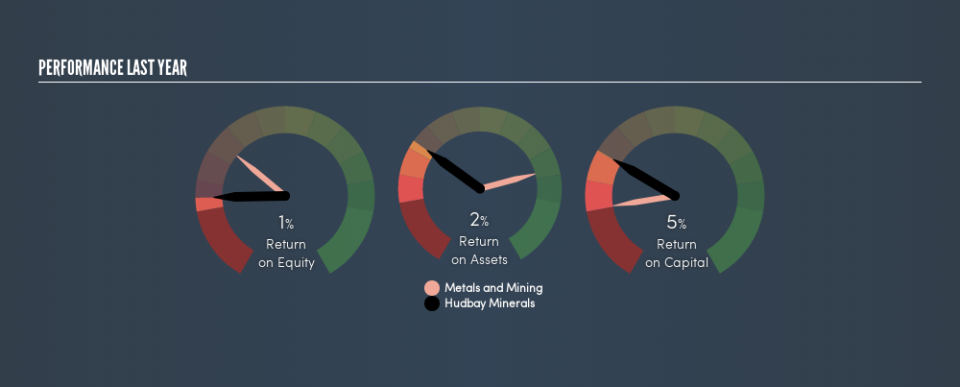Why Hudbay Minerals Inc.’s (TSE:HBM) Return On Capital Employed Is Impressive

Today we'll look at Hudbay Minerals Inc. (TSE:HBM) and reflect on its potential as an investment. Specifically, we'll consider its Return On Capital Employed (ROCE), since that will give us an insight into how efficiently the business can generate profits from the capital it requires.
First up, we'll look at what ROCE is and how we calculate it. Second, we'll look at its ROCE compared to similar companies. And finally, we'll look at how its current liabilities are impacting its ROCE.
What is Return On Capital Employed (ROCE)?
ROCE is a metric for evaluating how much pre-tax income (in percentage terms) a company earns on the capital invested in its business. In general, businesses with a higher ROCE are usually better quality. In brief, it is a useful tool, but it is not without drawbacks. Renowned investment researcher Michael Mauboussin has suggested that a high ROCE can indicate that 'one dollar invested in the company generates value of more than one dollar'.
How Do You Calculate Return On Capital Employed?
The formula for calculating the return on capital employed is:
Return on Capital Employed = Earnings Before Interest and Tax (EBIT) ÷ (Total Assets - Current Liabilities)
Or for Hudbay Minerals:
0.049 = US$215m ÷ (US$4.7b - US$307m) (Based on the trailing twelve months to March 2019.)
Therefore, Hudbay Minerals has an ROCE of 4.9%.
See our latest analysis for Hudbay Minerals
Is Hudbay Minerals's ROCE Good?
One way to assess ROCE is to compare similar companies. Hudbay Minerals's ROCE appears to be substantially greater than the 2.8% average in the Metals and Mining industry. I think that's good to see, since it implies the company is better than other companies at making the most of its capital. Regardless of how Hudbay Minerals stacks up against its industry, its ROCE in absolute terms is quite low (especially compared to a bank account). It is likely that there are more attractive prospects out there.
In our analysis, Hudbay Minerals's ROCE appears to be 4.9%, compared to 3 years ago, when its ROCE was 0.1%. This makes us think about whether the company has been reinvesting shrewdly. The image below shows how Hudbay Minerals's ROCE compares to its industry, and you can click it to see more detail on its past growth.
When considering ROCE, bear in mind that it reflects the past and does not necessarily predict the future. Companies in cyclical industries can be difficult to understand using ROCE, as returns typically look high during boom times, and low during busts. ROCE is, after all, simply a snap shot of a single year. We note Hudbay Minerals could be considered a cyclical business. What happens in the future is pretty important for investors, so we have prepared a free report on analyst forecasts for Hudbay Minerals.
What Are Current Liabilities, And How Do They Affect Hudbay Minerals's ROCE?
Short term (or current) liabilities, are things like supplier invoices, overdrafts, or tax bills that need to be paid within 12 months. The ROCE equation subtracts current liabilities from capital employed, so a company with a lot of current liabilities appears to have less capital employed, and a higher ROCE than otherwise. To check the impact of this, we calculate if a company has high current liabilities relative to its total assets.
Hudbay Minerals has total liabilities of US$307m and total assets of US$4.7b. As a result, its current liabilities are equal to approximately 6.5% of its total assets. Hudbay Minerals has a low level of current liabilities, which have a negligible impact on its already low ROCE.
Our Take On Hudbay Minerals's ROCE
Nonetheless, there may be better places to invest your capital. Of course, you might find a fantastic investment by looking at a few good candidates. So take a peek at this free list of companies with modest (or no) debt, trading on a P/E below 20.
If you like to buy stocks alongside management, then you might just love this free list of companies. (Hint: insiders have been buying them).
We aim to bring you long-term focused research analysis driven by fundamental data. Note that our analysis may not factor in the latest price-sensitive company announcements or qualitative material.
If you spot an error that warrants correction, please contact the editor at editorial-team@simplywallst.com. This article by Simply Wall St is general in nature. It does not constitute a recommendation to buy or sell any stock, and does not take account of your objectives, or your financial situation. Simply Wall St has no position in the stocks mentioned. Thank you for reading.

 Yahoo Finance
Yahoo Finance 
